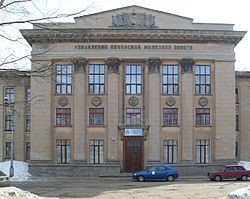Coat of arms Flag Area 80 km² Number of airports 1 | Urban okrug Kotlas Urban Okrug Local time Friday 11:03 PM | |
 | ||
Administratively subordinated to town of oblast significance of Kotlas Administrative center of town of oblast significance of Kotlas, Kotlassky District Weather 2°C, Wind S at 14 km/h, 85% Humidity | ||
Kotlas (Russian: Ко́тлас) is a town in Arkhangelsk Oblast, Russia, located at the confluence of the Northern Dvina and Vychegda Rivers. Population: 60,562 (2010 Census); 60,647 (2002 Census); 68,021 (1989 Census).
Contents
- Map of Kotlas Arkhangelsk Oblast Russia
- History
- Gulag
- Pechora railway
- Administrative and municipal status
- Economy
- Culture and recreation
- Sports
- Twin towns and sister cities
- References
Map of Kotlas, Arkhangelsk Oblast, Russia
Kotlas is the third largest town of Arkhangelsk Oblast in terms of population (behind Arkhangelsk and Severodvinsk) and an important transport hub.
History
The place was probably inhabited from ancient times, but was only granted official town status by the Provisional Government of Russia on June 16, 1917, when it was a part of Vologda Governorate. In 1918, the area was transferred to the newly formed Northern Dvina Governorate, and in 1924 the uyezds were abolished in favor of the new divisions, the districts (raions). Kotlassky District was formed on June 25, 1924. In 1929, Northern Dvina Governorate was merged into Northern Krai, which in 1936 was transformed into Northern Oblast. In 1937, Northern Oblast was split into Arkhangelsk Oblast and Vologda Oblast. Kotlassky District remained in Arkhangelsk Oblast ever since.
Gulag
During the 1930s, Kotlas became a place to which kulaks were deported and made to work in the forestry industry. It was managed by the Kotlaslag division of Gulag. Later, it hosted all possible categories of people repressed during the Stalin era. A significant population of Poles existed in the area, with whole Polish villages resettled here in 1920s and 1930s.
Labor camps existed within the territory of the city until 1953. Besides logging and paper industry, the occupation of inmates were plant, housing, bridge, and railroad construction. Most of camps were unguarded barrack settlements. In addition, Kotlas was a major transit point for deportees transferred further to the north and east, since it was a railroad terminus. There is a Kotlas branch of the Sovest (Conscience) organization, which seeks to preserve the memory of those times and seek compensation for victims.
Pechora railway
The further development of Kotlas is due to the construction of Pechora Railway. Already from 1899 Kotlas was connected by a railway line with Vyatka (currently Kirov), which was heavily used for the cargo transport of goods to and from the Northern Dvina River. In 1940, the construction of the railroad connecting Konosha (on the railway stretch between Moscow and Arkhangelsk) to Vorkuta started. The railroad was needed to transport coal, timber, and later oil from the Komi Republic. The headquarters of this railroad were opened in Kotlas. In the same year, Kotlas became a separate administrative unit. In December 1941, the road was completed, and from 1942, the regular service started. Kotlas thus became an important transport hub. The headquarters of the Pechora Railway were located in Kotlas until 1959, when the railway was merged into the Northern Railway.
Administrative and municipal status
Within the framework of administrative divisions, Kotlas serves as the administrative center of Kotlassky District, even though it is not a part of it. As an administrative division, it is, together with one work settlement (Vychegodsky) and two rural localities, incorporated separately as the town of oblast significance of Kotlas—an administrative unit with the status equal to that of the districts. As a municipal division, the town of oblast significance of Kotlas is incorporated as Kotlas Urban Okrug.
Within the framework of municipal divisions, Kotlas also serves as the administrative center of Cheryomushskoye Rural Settlement, even though it is not a part of it.
Economy
Kotlas is a center of timber industry and an important river port and a railroad center (standing on the railroad connecting central Russia with the Komi Republic).
The Northern Dvina and the Vychegda Rivers are navigable; there is regular passenger navigation on the Vychegda. Roads connect Kotlas with Veliky Ustyug (and eventually Vologda and Kostroma) to the South, Syktyvkar to the East, and Krasnoborsk (eventually Arkhangelsk) to the North. There is regular passenger bus traffic originating from Kotlas.
Kotlas is an important railway hub, where the railway to Kirov branches off south-east from the main railway, connecting Konosha and Vorkuta.
Kotlas is served by Kotlas Airport and is home to Savatiya air base.
Culture and recreation
The Church of St. Stephan of Perm was built in 1788, and the adjacent bell-tower was built in 1825. Both are protected at the local level as architecture monuments, as well as Narodny Dom, a wooden house built in the beginning of 20th century.
Sports
Salyut is the local bandy club.[1] Alexandr Tyukavin, a notable player, voted to be the third best player of the Russian National Championship 2011–2012, was born in Kotlas. In 2014 he was awarded a prize from the International Fair Play Committee.[2]
Twin towns and sister cities
Kotlas is twinned with:
